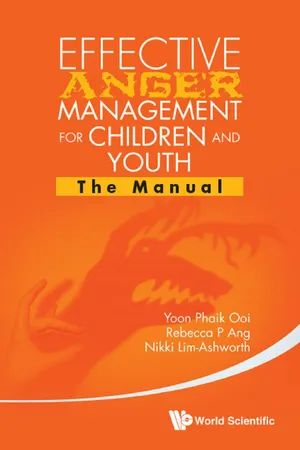
Effective Anger Management For Children And Youth: The Manual And The Workbook
The Manual and the Workbook
- 140 pages
- English
- ePUB (mobile friendly)
- Available on iOS & Android
Effective Anger Management For Children And Youth: The Manual And The Workbook
The Manual and the Workbook
About This Book
The Effective Anger Management for Children and Youth manual and workbook are specially designed for teachers, counsellors, social workers, psychologists, and other mental health professionals who assist in various capacities in working with children who exhibit anger and aggression problems. The ideas, materials, suggested activities and games included in this resource book are applicable to both primary and secondary school children. The purpose of this resource book is to provide practical strategies divided into 12 lessons that teachers and mental health professionals can implement; it is a “how to” book on enhancing children's emotion management, problem-solving and social skills.
Contents:
- Identification of Feelings in Ourselves and Others
- Exploring Anger Feelings
- Anger Coping Techniques I
- Anger Coping Techniques II
- Empathy Skills
- Perspective-Taking Skills
- Fighting Fair
- Building Prosocial Skills
- Effective Problem-Solving Steps: ANGER Plan
- Application of the ANGER Plan I
- Application of the ANGER Plan II
- Putting It All Together
Readership: For teachers, counsellors, social workers, psychologists, and other mental health professionals who assist in various capacities in working with children who exhibit anger and aggression problems.
Key Features:
- There is currently no such published manual and workbook in Southeast Asia. The book is tailored to suit Asian children/adolescents
- Analogies, case scenarios, and examples were designed to reflect the daily encounters faced by these children/adolescents
- The language used is also tailored to suit Asian children/adolescents
Frequently asked questions
Information
Session 1: | Identification of Feelings in Ourselves and Others |
Session 1
Identification of Feelings in Ourselves and Others
















Table of contents
- Cover Page
- Title
- Copyright
- Contents
- About the Authors
- Acknowledgements
- Introduction
- Session 1 Identification of Feelings in Ourselves and Others
- Session 2 Exploring Anger Feelings
- Session 3 Anger-Coping Techniques I
- Session 4 Anger-Coping Techniques II
- Session 5 Empathy Skills
- Session 6 Perspective-Taking Skills
- Session 7 Fighting Fair
- Session 8 Building Prosocial Skills
- Session 9 Effective Problem-Solving Steps: ANGER Plan
- Session 10 Application of the ANGER Plan I
- Session 11 Application of the ANGER Plan II
- Session 12 Putting It All Together
- Appendices
- References
- Title
- Copyright
- Contents
- Session 1 Identification of Feelings
- Session 2 Anger Signals
- Session 3 My Practice Diary
- Session 4 FiRM
- Session 5 Everyone Has Feelings
- Session 6 Perspective-Taking
- Session 7 What is Fighting Fair?
- Session 8 Prosocial Skills
- Session 9 The Five-Step ANGER Plan
- Session 10 ANGER Plan Review
- Session 11 Using the ANGER Plan to Resolve My Problem (For Younger Children)